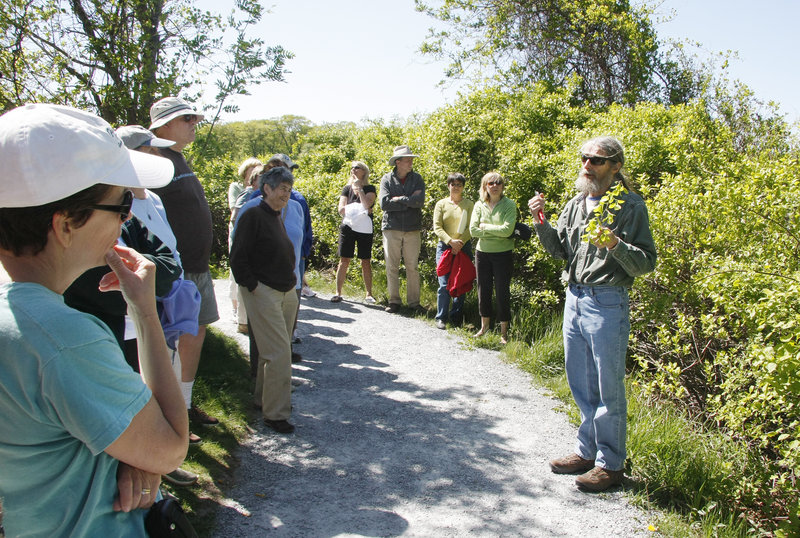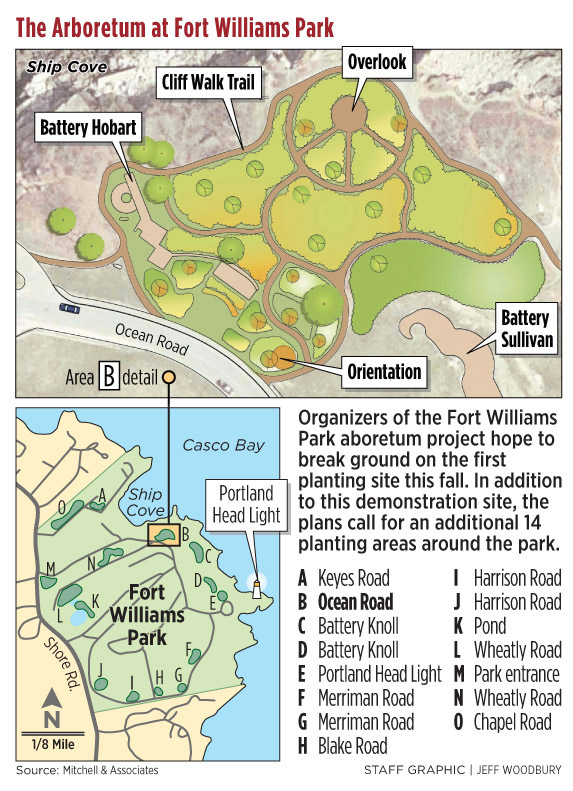CAPE ELIZABETH – Visitors to Fort Williams Park may start noticing some changes in the landscape this fall.
Organizers of an arboretum project hope that work will be under way by then at the first of 15 planting sites. They are now ramping up their fundraising efforts toward that goal.
The first planting area will serve as a demonstration site. It is the largest and will enjoy a prominent location, just beyond Ship Cove as visitors head toward Portland Head Light. Its visibility is meant to draw attention to the arboretum’s mission: the removal of exotic invasive species that pose a threat to the native species that will replace them.
Norway maple, Asian bittersweet, multiflora rose. Japanese barberry and autumn olive are some of the exotic invasives common in the park, said Rick Churchill, a horticulturist and former town tree warden who is part of the effort behind the arboretum.
Some of the invasives were initially embraced as ornamentals or planted widely as fast-growing erosion control, as was the case during the expansion of the highway system during the Eisenhower administration, Churchill said. But without the diseases and pests that keep these plants in check in their native lands, they are able to out-compete native species.
“A lot of the ones we consider the bad guys of plants, when we put them in they were considered the good guys. Times change,” Churchill said.
The total cost of the demonstration site, which will cover 1.1 acres, is estimated at $350,000, according to Kathryn Bacastow, a former town resident leading the arboretum steering committee.
That figure includes room for error and assumes that the project would rely entirely on paid labor, so the actual costs may be lower. Organizers hope volunteers and in-kind donations will be part of the project, Bacastow said.
The group needs about $80,000 to begin work on the demonstration site and has already made good progress toward that, Bacastow said, even though it has not started actively soliciting donations.
Some of the first work will involve hand-clearing of invasives, although heavy construction equipment will also be needed.
The specific plants for the site have not yet been determined, but they could include low- and high-bush blueberry, junipers, checkerberry and American hornbeam.
The success of the demonstration site could give the rest of a privately funded project a boost. The plans call for 15 sites or varying sizes to be scattered around the 90-acre park on existing walkways — an endeavor that could take many years and cost $3.5 million in all.
“If this demonstration site ends up being a ‘wow’ and it’s visible, people will say, ‘Now I understand what you’re talking about,’” Bacastow said.
The arboretum group’s work will help the town at a time when funds for park maintenance are limited, said Maureen McCarthy, chairwoman of the town’s Fort Williams Advisory Committee
Residents next month will weigh in on a proposal to charge parking fees at the park, a change that would generate revenue for repair projects. The June 8 vote is advisory, and the Town Council will make the final decision.
The arboretum fits in with the vision laid out in the master plan for the park, McCarthy said. The problem of invasive species and issue of tree management are among the issues it addresses.
“I do think there’s a genuine enthusiasm and interest in it,” she said.
That description could fit Dennis Yesse’s reaction upon learning about the arboretum project. The South Portland resident is a frequent visitor, exercising at the Fort Williams nearly every day and bringing his family to enjoy the park on the weekend.
“What’s not to like about it?” he asked. “Whatever makes the park more natural and beautiful. It’s perfect.”
Staff Writer Ann S. Kim can be contacted at 791-6383 or at: akim@pressherald.com
Send questions/comments to the editors.



